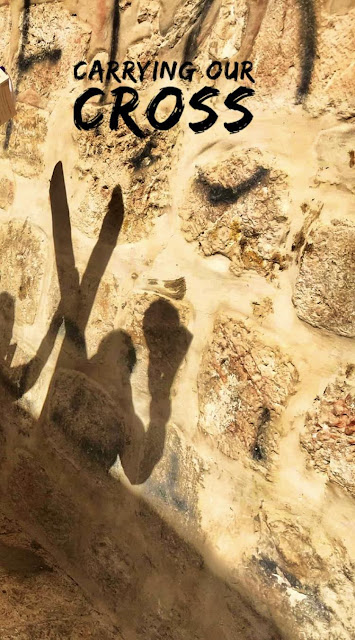I couldn’t believe it! It’s been almost a year since I wrote this blog. Aside from the many things that happened, I’ve been focusing on my faith blog and didn’t have the chance to finish this. But I always say God’s timing is perfect. Things happen when He wants them to happen. It is with both gratitude and sadness that I reminisce on our Holy Land trip. Gratitude for the chance to visit the place where Jesus walked before all the hostilities happened. Sadness because of the war going on in Israel right now. I pray for peace, that the Israelites and Palestinians will learn to live in harmony. I also pray that the holy sites may not be affected so that many more people will still get to see them and remember that it was here where God sent His only son to live among men.
With that being said, let’s continue the journey.
VIA DOLOROSA
On the 8th day of our pilgrimage, we
not only followed Jesus’ footsteps, but we also carried His cross. Our whole
morning was spent in Jerusalem tracing the Via Dolorosa, a processional
600-meter route in the Old City of Jerusalem from the former Antonia Fortress
to the Church of the Holy Sepulcher. After entering the city through Herod’s
gate,
we made our way to the Church of Flagellation,
site of the 1st Station, where we were given a wooden cross to
carry. Each group took turns in carrying it as we prayed the Stations of the
Cross around the streets of the Jerusalem market.
“As they were coming out, they found a man of Cyrene named Simon, whom they pressed into service to bear His
cross.” – Matthew 27:32
A sob almost escaped my throat when we took our
turn at the cross. Unlike Simon of Cyrene, we were willing to carry this
burden. Connecting with Jesus by carrying His cross made me emotional. Experiencing
how Jesus was rejected by the people cut deep. Before we started, Bro Arun Gogna
told us to take note of our surroundings. It is exactly as it was in Jesus’
time – a marketplace where people ignored his suffering as he carried the
cross. True enough, we too were ignored. People passed by without throwing a
glance at our group, sometimes shoving us a bit in their rush to overtake us.
Along the bustling streets of the Old City, we
solemnly made our way passing the 2nd to the 8th Stations:
- 2nd
Station – Church of the Condemnation and Imposition of the Cross
- 3rd
Station – Armenian Polish Catholic Church
- 4th
Station – Armenian Church of Our Lady of the Spasm
- 5th
Station – Franciscan Chapel of Simon of Cyrene
- 6th
Station – Greek Catholic Church of the Holy Face
- 7th
Station – Franciscan chapel
- 8th
Station – Chapel of St. Charalampos
At the entrance to the Ethiopian Orthodox
Monastery (Deir Al-Sultan) and the Coptic Orthodox Monastery of Saint Anthony where
the 9th Station marker was, we had to leave the cross. These 2
churches together form the roof of the Church of the Holy Sepulcher.
 |
| Monk guarding the entrance to the Ethiopian Orthodox Monastery at Deir Al-Sultan |
We descended from the roof and followed a
circuitous route through the bazaar to reach the Parvis or the courtyard facing
the entrance of the Church of the Holy Sepulcher. The 10th Station is
in the Chapel of the Franks (also called Chapel of the Torment, Chapel of the
Seven Sorrows of the Blessed Virgin Mary or Our Lady of Sorrows) which was
accessible from the Parvis.
We then entered the Church of the Holy
Sepulcher (also known as Church of the Resurrection or Church of the Anastasis).
It is a magnificent edifice shared by different Christian denominations. The
main building has chapels run by the Greek Orthodox, Roman Catholic (called
Latins in Israel) and Armenian Apostolic churches. The Coptic Orthodox
(Egyptians), Syriac Orthodox, Ethiopian Orthodox churches occupy other parts of
the church. An interesting trivia about this set up is that the key is kept by
a Muslim to keep the peace.
Joining a throng of pilgrims, we climbed the
stairs to Calvary where the 11th to the 13th Stations
were located:
- 11th
Station - Catholic Chapel of the Nailing to the Cross
 |
| Above the altar: 12th century mosaic of Jesus being nailed to the cross |
- 12th Station -
Greek Orthodox Chapel of the Crucifixion’s Altar where the rock of Calvary is encased in protective glass
- 13th Station – Catholic altar of Our
Lady of Sorrows
Finally, we made our way down to the 14th
Station at the Edicule, a 19th century shrine where the empty tomb of Jesus is enclosed. It is in the Rotunda under
the Dome of the Anastasis.
The spot that intensified the sense of Jesus’
suffering for me was the Stone of Anointing or Stone of Unction where Jesus’
body is said to have been laid after He was brought down from the cross and
anointed before burial. As I gazed at the 3-part mosaic depicting the Descent
from the Cross, Anointing of Jesus’ Body, Burial of Jesus on the wall beside
the slab, I was one in sorrow with the Blessed Mother and His disciples.
 |
| Stone of Anointing |
Our morning tracing the Via Dolorosa made us
keenly aware of what Jesus suffered for our sake.
I’ll tell you about the other places we visited
on our 8th day in my next blog as I feel Christ’s Passion deserves
to be experienced on its own even virtually by my readers.





.jpg)